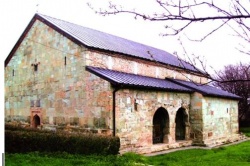Bolnisi Sioni

Bolnisi Sioni, one of the most important monuments of ancient Georgian architecture, is a three-naval basilica (three-church basilica). It is located 70 kilometers south of Tbilisi, in Kvemo Kartli, in Bolnisi Village (Bolnisi region).
According to the inscription on the Northern entrance to the church, it was built in 478-493 (see Bolnisi Inscriptions). Here, Vakhtang Gorgasali (the 5th century) founded an episcopal cathedral that existed until the second half of the 18th century.
The building is clad with beautiful turquoise-green colored and cleanly cut tuff squares. Naves are separated from each other by five pairs of columns that form the x-shape. The altarpiece protrudes from a semi-circle apse. It does not have the credence table and sedilia. Along the northern facade, there is an open arched gallery. On the southern side, there is a relatively small arched stoa. Furthermore, there is a separate baptistery that can only be entered through the church (such examples of separate baptisteries are rare in Georgia). On top of the entrance, above the string horizontal lintel, there are c-shaped lunettes. The inner arches are also C-shaped. The middle nave was covered by a barrel vault (the most recent one dates back to the 17th century), while the side naves have half vaults. From the outside, all three naves have double-pitched roofs.
Bolnisi Sioni has a strict, monumental interior, which was common in early feudal Georgian architecture. Artistic decisions take center stage in the interior. Facades carry secondary importance. The lack of the western entrance (the current entrance from the west wall was a 17th-century addition) suggests the influence of the traditional Georgian central compositions. The entrances are in linear walls – one from the south and two from the north. This was in direct contrast to the basilica’s “linear” design (everything in the basilica must be built along the linear lines in the direction from west to east towards the altar).
Bolnisi Sioni is not interesting only because of its architecture - we encounter for the first time sculptural and ornamental adornments. The north gallery, nave pilasters, and the pillars of the baptistry are adorned by bas-reliefs and carvings. There are geometrical and floral patterns that reveal similarities to Sassanid-style ornamentation. There also are Christian symbols – various depictions of the Cross. One of them is called “the Bolnisi Cross” (a cross with arms that are narrow at the center and flared in a curved line shape, surrounded by a circular frame).
In Bolnisi Sioni, we encounter for the first time in Georgian architecture the depictions of relief sculptures (head of a bull, various birds and animals, horses with other animals), which are connected to the pre-Christian era. However, the Christian faith appropriated these images. The cross, a symbol of the new faith, is prominently featured. Bolnisi Sioni reveals the connection between Georgian and other Christian basilicas. However, the Georgian church still retains its stark individuality. A small chapel, which is attached to the eastern side of the church, belongs to the 8th century.
Over time, this monument was damaged and crumbled. The north stoa with arches was destroyed as well. In 1634, during the Persian Invasions, part of the western wall and the vault were heavily damaged. In the first half 17th century, Queen Mariam and King Rostom ordered the rebuilding of the deteriorated parts (mostly with brick). The western door was added at that time. In the 17th century, Bolnisi Bishop Nikoloz had the church renovated and painted; he also had the bell tower built around that time.
Bolnisi Episcopacy was dissolved in the first years of the 18th century.
Since ancient times, active literary work took place in this church. Famous writer and preacher Ioane Bolneli (10th-11th centuries) worked here. There are famous manuscripts written by the scholars of Bolnisi Sioni.
G. Chubinashvili started studying Bolnisi Sioni in 1916. In 1936-37, L. Muskhelishvili supervised restoration works and research. They excavated the monument, cleaned it, and revealed the hidden parts of the building. They also found fragments of previously unknown inscriptions - including construction details that aided in precisely dating Bolnisi Sioni. They repaired, strengthened the structure, and covered it with a new roof.
In 1967-69, R. Gverdtsiteli supervised restoration and construction works. They roofed the northern gallery, reconstructed its west wall, and put one of the oldest inscriptions in its place. They put up a new stone floor.
Bolnisi Sioni has been functioning as a Georgian Orthodox church since 1989.
Literature: ბ ე რ ი ძ ე ვ., ძველი ქართული ხუროთმოძღვრება, თბ., 1974; მ უ ს ხ ე ლ ი შ ვ ი ლ ი ლ., ბოლნისი, «ენიმკის მოამბე», 1938, ტ. 3; ჩ უ ბ ი ნ ა შ ვ ი ლ ი გ., ქართული ხელოვნების ისტორია, ტ. 1, ტფ., 1936; მისივე, Болнисский Сион, «ენიმკის მოამბე». 1940, ტ. 9.
V. Beriddze
L. Menabde


